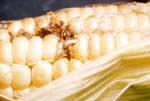
|

Sap
Beetles
Carpophilus spp.
Picnic Beetle Glischrochilus quadrisignatus
Description
The picnic beetle (Fig. 1) is black with four prominent orange
or yellow spots on the wing covers, which are shorter than the
abdomen. This insect is found in decaying fruit and also in
the ears and stalks of corn that has been damaged by the corn
earworm and corn borer. The corn sap beetle is a tiny brown
beetle found in the ears of corn that have been damaged by earworm
or corn borer. The wing covers do not extend over the entire
abdomen. The eggs, which are laid singly, are white and slender,
resembling a house fly egg. The larvae of both species are active
white to cream-colored worms with bromn heads. They pupate in
the soil. |
Click
on image for larger version

Figure
1. Sap (or Picnic) Beetle Adult
|
|
Click
on image for larger version

Figure
2. Sap (or Picnic) Beetle Adult
|
Life
History
Little is known about the life cycles of these two beetles.
This information comes largely from field observations made
by staff members of the Natural History Survey. The insects
may winter as larvae or adults in decaying vegetation, debris,
and fruit buried in the soil. They emerge in the spring and
lay their eggs on spoiling or rotting vegetation. Later they
also lay eggs in the silks and kernels of damaged corn. The
larvae feed in this decaying material until they are full grown,
then they drop to the soil to pupate. Apparently there are two
or more generations each year. |
|
Damage
These beetles are best recognized by their food habits. Apparently
they do not normally attack healthy plants, but work on injured
spots on growing plants. They particularly like tomatoes,
all fruits, and ears of corn. Growth cracks in tomatoes may
be full of these beetles. Over-ripe or bruised apples, peaches,
strawberries, and raspberries are also subject to attack.
Both species of beetles follow injury to ear corn. Since they
lay eggs in the silks, the larvae feed in the ear and are
suspected of being primary pests.
|
Click
on image for larger version

Figure
3. Sap (or Picnic) Beetle Larva
|
Control
Since spoiling plant material is required to attract these beetles,
good control of insects and diseases will largely prevent trouble.
Pick berries and fruit before they become over-ripe. Handle them
carefully to prevent bruising. Destroy all rotting fruits and vegetables.
Control of ear-worms and borers means less trouble with corn sap
beetles. Thus a clean crop is the best insurance against annoyance
by these beetles. Control is rarely justified in commercial field
corn. In seed production fields, treatment may be warrented when
there are ten or more adults per ear tip on 25% of the plants during
the blister or milk stage.
Authors:
Susan T. Ratcliffe (sratclif@uiuc.edu)
Michael E. Gray (m-gray4@uiuc.edu)
Kevin L. Steffey (ksteffey@uiuc.edu)
|
|

|

|



